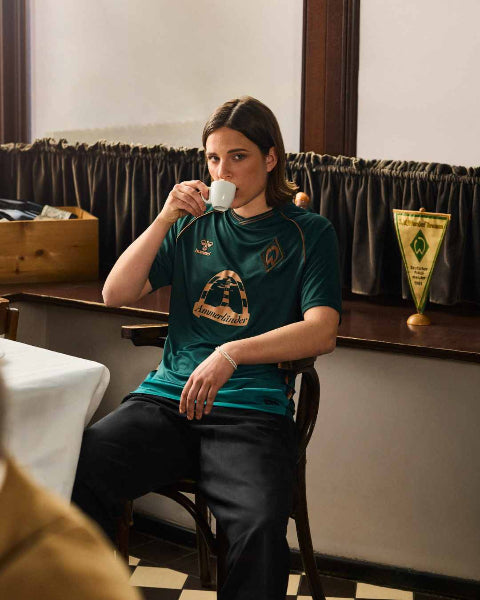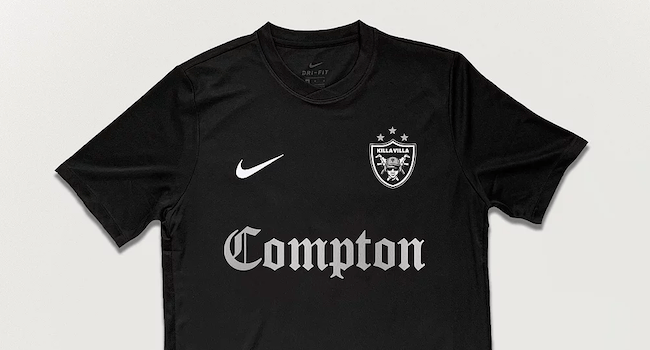Recently added
Vintage shirts
Concept kits
Legends
How to store football shirts
by Phil Delves February 05, 2022 7 min read

You’ve washed your football shirts correctly, and you’ve skillfully avoided accidentally picking up any fakes, but now you need to figure out to store all these kits you own.
Like many things when it comes to collecting, this is something which only really becomes a consideration after x number of shirts, but whether you own a fledgling ‘start-up’ of a collection or an exhibition’s worth of designs, the last thing you want to do is damage a shirt by storing it carelessly.
Collectors Club Blogs
Let’s get down to business. Joining us today is collector and avid Manchester United fan Dominic Conrad, a rising name in the shirt community who we spoke to in June.
I’ll also be chipping in alongside Dom to offer my own thoughts.
How to store football shirts
1. When hanging shirts, avoid wire hangers and consider dust bags
Probably the most common method of storing football shirts is with the humble hangar. They’re easy to find (you probably already have some!), you can easily scale up or down depending on the size of your collection, and you have a variety of possible places you can hang including a wardrobe or freestanding unit.
Hangers are a great option, but there’s one golden rule you should follow if you go down that route. Don’t use wire hangers. Wire hangers are riskier when it comes to pulls, and for more delicate shirts they're also more likely to leave marks or creases.
Dom: Personally, I simply store all my shirts hanging on thick hangers in the closet or wardrobe. Never use wire hangers if you’re going to hang your shirts.
It’s also worth considering using dust bags, especially for the rarer, older shirts in your collection.
Dom: For my older shirts like my 80s and early 90s shirts with sponsors or numbers susceptible to sticking or damage, I will hang them with a dust bag over them.
Dust bags also have the added benefit of helping to protect against moths. Whilst moths won't eat their way through more modern, synthetic shirts, older shirts made of cotton or other organic materials may be a tastier proposition!
Two of these 🤩😎 pic.twitter.com/HzKbNLNuBL
— ernashirts (@ernashirts) August 18, 2020
Back to the the option of hangers, be extra careful not to let a shirt hang too close to the hinges of a cupboard door.
Phil: I once punched a hole clean through the sleeve of a player issue shirt after it got caught in a door hinge. Thankfully I was able to sell the shirt despite the damage, but it’s fair to say I checked twice before shutting my wardrobe door after that!
2. When using a box or plastic wallet, include silica gel
Another popular storage solution involves a combination of plastic zippable wallets and/or boxes. This is a particularly good method if you don’t plan on wearing your collection often, as you’ll have a lower chance of accidentally snagging a shirt as you move things in and out your wardrobe.
Once again there are various types of boxes and wallets you can use, but regardless of what option you use, it’s always worth adding a pack of silica gel to each container. Packs are readily available online, and you’ll help absorb any moisture that might build up over time.
Phil: Most of my collection is stored in individual zippable wallets, piled inside some steel boxes. Each wallet has a packet of silica gel inside, to help absorb any moisture.
Reply with a picture showing how you store your football shirts. 📦 pic.twitter.com/wKEjEUmJjE
— Football Shirt Collective (@thefootballsc) August 17, 2020
Dom: Hanging is not the only option for storage of course. There are great ideas like folding your shirts and keeping them in display shelves, your drawers, or even in individual bags. Boxes are good for those of you who don’t wear your collection regularly.
160 Córdoba CF shirts. In bags one by one. 6 boxes 😄 pic.twitter.com/u36xxjK0qj
— Rubén Castro (@RubenCastroCCF) August 17, 2020
Where can I buy plastic zippable wallets?
Thanks to Chris on Twitter who followed up by asking what sort of wallets to buy. See the thread below for some more info.
@phildelves Hi Phil, have just read an article on @thefootballsc website about storing shirts. I’ve had 50 shirts stuffed under the bed for years, all have just been washed (only 1 casualty!) and see that you use zippable wallets for yours. Any tips on size and type to buy? Chris
— Chris H (@Chris_H1301) July 7, 2021
Reply with a picture showing how you store your football shirts. 📦 pic.twitter.com/wKEjEUmJjE
— Football Shirt Collective (@thefootballsc) August 17, 2020
3. Avoid folding sponsors or leaving them exposed to sunlight
If you do opt for some sort of box or wallet solution, be sure to avoid folding sponsors as best as you can. Pretty much every sponsor, old or new, is susceptible to creasing and damage if folded over time, and newer sponsors are particularly liable to damage.
It can be tricky, but experiment with different methods and container sizes.
Phil: In my experience an A3 wallet is the perfect size to avoid having to fold any sponsors too, and the shirts also look quite presentable even in the wallets. I've had to store a couple of shirts horizontally to accommodate unusually large sponsors, but the presentation still looks as good.
Dom: If you’re not hanging your collection, make sure the shirt is folded neatly and handled with care as to preserve the print, sponsors or keep your shirt in generally good condition.
4. Always clean shirts before storing
So you’ve just received an auction win from eBay, and you burst open the pack and proudly add the shirt alongside the rest of your collection. There’s a bit of a funny smell, but you ignore it.
Stop.
Don’t ignore the smell. As soon as you hang the shirt alongside everything else, you’re just increasing the chances that your other shirts will start to smell. Don’t leave anything to chance, and wash your shirts (following our advice from a previous edition of Collectors Club) before storage.
Phil: The number one thing for me is smell. If I receive a second hand shirt and there’s even a hint of body odour, it’s going straight in the wash (following all the necessary precautions like we discussed previously on Collectors Club, of course).
5. Avoid ironing shirts if you can
Though it’s possible to iron many shirts, in practice it’s usually best to avoid doing so. It’s all too easy to go a little too hot and damage your shirt beyond repair, and some shirts feature materials that will easily melt at even low temperatures.
If you do want to get any creases out of shirts, “old-school” methods like steaming them in the bathroom whilst you’re having a shower, or flattening creases with a heavy book, are worth trying first. If all else fails and you do opt for the iron, proceed with great caution.
Dom: I’m sure it can be done if done so carefully, but personally I have never nor will I ever iron any of my shirts. It’s not worth the risk of accidentally ironing at too high a temperature and ruining the shirt.
Phil: Honestly, I’m too scared to put an iron anywhere near my shirts.
That being said, it’s certainly possible and many shirts should be thick enough and made of the right sort of material even to apply an iron directly at a relatively low heat. But this will vary from shirt to shirt, and again I would always err on the side of caution and try other methods to get rid of any creases, such as steaming them in the bathroom or even grabbing a heavy book off the shelf.
In random boxes.. I really should know better! 😁 pic.twitter.com/g4KgH4YSYn
— kitfanatic (@kitfanatic) August 17, 2020
6. Avoid particularly high or low temperatures when storing shirts
One common theme throughout this subject is the need for good temperature control. Whether you’re hanging, using boxes or storing in plastic wallets, you want to treat your shirts like a tin of beans: avoid direct sunlight or particularly cold temperatures.
Check on your shirt regularly to assess them for any moisture or damage, and don’t be afraid to switch methods if your chosen solution causes any issues.
Dom: When I used to store shirts in boxes or drawers, I had the odd creased sponsor or number which is why I started hanging them. The worst thing ever was probably transporting my shirts in the car on a trip and leaving them hanging on the clothing rack overnight and returning to find a melted sponsor on an old Inter shirt. That being said, make sure your shirts never get too hot somehow (goes for washing as well).
Good storage and temperature control is vital if you want to sell on any shirts also. For a collection that you’re going to wear to death, you can get away with the odd snag, but any imperfection knocks off the £s when it comes to sell.
Phil: Always plan ahead when it comes to shirts in your collection.
If you’re planning to sell shirts on for profit, you probably shouldn’t wear them (as tempting as it might be!). Naturally your storage of the shirts should involve as little contact with other shirts, sunlight or particularly high or low temperatures.
On the flipside, if you’re someone who wants to wear their shirts as much as possible your options will open up in terms of how you store the shirts. Still, avoid being careless so you can get the most out of your kits.
Thanks to Dom for helping us out today. Be sure to follow him and his collection over on Twitter.
If you enjoyed this piece, make sure you're caught up with the other articles in Collectors Club. You'll find pieces about washing your football shirts and spotting fakes here.
Phil Delves
As Head of Content, Phil is the creative playmaker of the team, covering every angle of football shirt news in our blogs and weekly Newsletter. Whether it's telling your fakes from your authentics, or deep dives into the newest football shirts designs, Phil will have all your football shirt content needs covered.
Sidebar
- Premier League football shirts
-
Other English clubs
- Birmingham City
- Blackburn Rovers
- Charlton Athletic
- Coventry City
- Derby County
- Hull City
- Ipswich Town
- Leicester City
- Middlesbrough
- Millwall
- Norwich City
- Portsmouth
- Preston North End
- Queens Park Rangers
- Sheffield United
- Sheffield Wednesday
- Southampton
- Stoke City
- Swansea City
- Watford
- West Bromwich Albion
- Scottish clubs
- Italian club shirts
- Spanish club shirts
- German club shirts
- International
- French club shirts
- Rest of the world
-
Legends
- Adriano
- Alessandro Del Piero
- Andrey Arshavin
- Alvaro Recoba
- Bobby Moore
- Bryan Robson
- Bukayo Saka
- Clarence Seedorf
- Cristian Vieri
- Cristiano Ronaldo
- David Beckham
- David James
- David Seaman
- David Ginola
- Dennis Wise
- Dennis Bergkamp
- Didier Drogba
- Dimitar Berbatov
- Diego Maradona
- Edgar Davids
- Eric Cantona
- Fernando Torres
- Freddie Ljungberg
- Gabriel Batistuta
- Gianluca Vialli
- Gianluigi Buffon
- Giovanni Elber
- Frank Lampard
- Francecso Totti
- Haaland
- Harry Kane
- Hidetoshi Nakata
- Ian Wright
- Jari Litmanen
- Ji Sung Park
- Juninho
- Jurgen Klinsmann
- Kaka
- Landon Donovan
- Lionel Messi
- Lothar Mattaus
- Luis Figo
- Mark Viduka
- Matt Le Tissier
- Mesut Özil
- Michael Owen
- Mikel Arteta
- Neymar
- Nicolas Anelka
- Nwankwo Kanu
- Paolo Di Canio
- Paolo Maldini
- Patrick Vieira
- Rafael Van der Vaart
- Raul
- Riquelme
- Rivaldo
- Robert Pires
- Roberto Baggio
- Robbie Fowler
- Ronaldo Nazario
- Ronaldinho
- Roy Keane
- Rudi Voller
- Ruud Gullit
- Ryan Giggs
- Santi Carzola
- Steve Bull
- Steven Gerrard
- Teddy Sheringham
- Thierry Henry
- Tony Adams
- Toto Schillaci
- Tugay
- Wayne Rooney
- Xabi Alonso
- Zinedine Zidane
- Zola
- Brands
Subscribe
Sign up to get the latest on sales, new releases and more …













